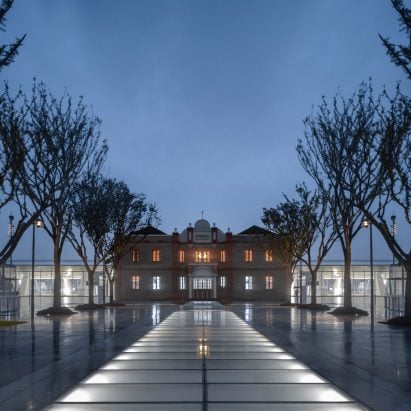Chinese architecture studio MAD has rebuilt a historic station and created an underground terminal at the central train station in Jiaxing, China.
The revamp of the 354,000-square-metre building is MAD‘s first station and the studio hopes it will “redefine transportation infrastructure buildings in China”.
MAD designed Train Station in the Forest in Jiaxing
The studio created an underground terminal with a public park created at ground level along with a full-scale replica of the original 1907 station recreated as the north entrance to the building.
The 210,000 red and green bricks used for the reconstruction are made of mud sourced locally mainly from the nearby South Lake.
The studio rebuilt the original 1907 station
The size of the station, which is expected to be used by 5.28 million people a year by 2025, was increased from five tracks to six tracks.
To increase capacity, two sunken waiting halls were built on either side of the existing overground platforms.
A metal roof and glass facade contrast the brick station. Photo is by Aogvision
These underground waiting halls havemetal roofs equipped with solar panels that power the station, contrasting the brick exterior of the old station front.
The glass facade and skylights allow natural light into the building, while allowing a clear view of the reconstruction of the old station front from inside the building.
The exhaust vents, broadcasting system, and underpass light strips were embedded into the walls to create a minimalist interior. Anodised aluminium honeycomb panels are also used on the interior walls for noise absorbing.
Skylights and glass curtain walls light up the interior. Photo is by Aogvision
According to MAD’s founding partner Ma Yansong, train stations in China have grown too large and Train Station in the Forest was designed to be less imposing that other recently built stations.
“They stand like imposing palaces in Chinese city centres surrounded by wide main roads, viaducts, and vast empty squares,” said Ma.
“We should rethink and redefine the spatial patterns of such transportation infrastructure buildings in China,” he continued.
“We can break away from the common pursuit of grandiose monumental buildings and make them urban public spaces with transport functions, natural ecology and cultural life, where citizens are happy to go, stay, meet, and enjoy.”
The recreated old station is visible from inside the building
On the Northside of the station trees were planted to connect the building to an existing public park.
A total of 1,500 trees were planted across the site, with beech trees lining the central axis of the north square that are intended to create a canopy when fully grown, which the name of the project Train Station in the Forest came from.
Green outdoor space can be used for public events. Photo is by Su Shengliang
At the centre of the south square is a landscaped lawn of about one hectare, with seven buildings arranged around it.
These circular buildings were designed to connect the above and below ground circulation routes, with sunken courtyards connecting them all to the lawn where outdoor events and festivals can be hosted.
Commercial and cultural spaces are added to the south square. Photo is by Su Shengliang
“Our design priorities the emotional and spiritual needs of citizens, brings in natural landscapes, and integrates urban spaces and building volumes into nature,” MAD said.
“Through careful traffic planning and employing a vertical use of space, our scheme meets the station’s existing passenger demand while leaving room for future sustainable development and expansion,” it added.
Elsewhere in China, MAD has recently revealed proposals for a few cultural projects including the sinuous Nanhai Art Centre in Guangdong and Anji Culture and Arts Centre with roof shaped like bamboo leaves.
The photography is by CreatAR Images, unless stated otherwise.
Project credits:
Architect: MAD
Principal partners in charge: Ma Yansong, Dang Qun, Yosuke Hayano
Associate partners in charge: Liu Huiying, Tiffany Dalhen
Design team: Yao Ran, Yu Lin, Cao Chen, Chen Nianhai, Cheng Xiangju, Reinier Simons, Fu Xiaoyi, Chen Wei, He Shunpeng, Li Zhengdong, Cao Xi, Zhang Kai, Li Xinyun, Kaushik Raghuraman, Deng Wei, Huang Zhiyu, Huai Wei, Sun Mingze, Dayie Wu, Hou Jinghui, Yin Jianfeng, Claudia Hertrich, Liu Zifan, Xie Qilin, Alan Rodríguez Carrillo, Qiang Siyang
Executive architects: Tongji Architectural Design (Group) Co., Railway Siyuan Survey and Design Group Co.
Heritage consultant: Shanghai Shuishi Architectural Design & Planning Corp.
Landscape consultant: Z’scape Landscape Planning and Design
Lighting consultant: Beijing Sign Lighting Industry Group
Signage consultant: NDC CHINA
Interior design consultant: Shanghai Xian Dai Architectural Decoration & Landscape Design Research Institute Co.
Structural consultant: LERA Consulting Structural Engineers
Facade consultant: RFR Shanghai
Construction contractor: China Railway Construction Engineering Group, China Tiesiju Civil Engineering Group, China Construction Eighth Engineering Division Co.
The post MAD unveils sunken Train Station in the Forest in Jiaxing appeared first on Dezeen.
